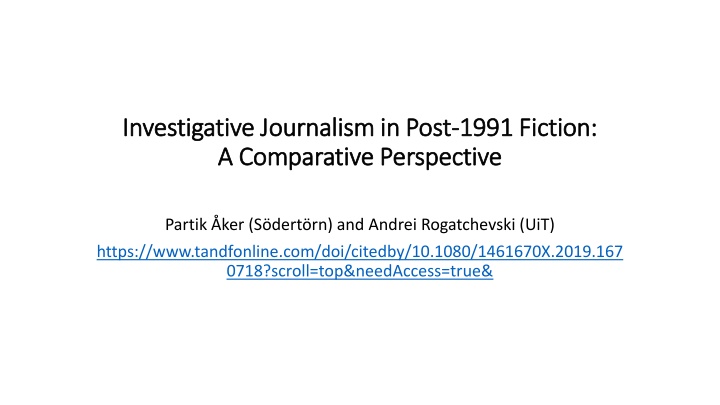
Comparative Perspective on Investigative Journalism in Post-1991 Fiction
Explore the challenges faced by investigative journalists in Russia, Sweden, and the USA through the lens of crime fiction post-1991. Discover how different press traditions and media landscapes shape the portrayal of truth-seeking protagonists in a post-truth era. Dive into novels by various authors as a tool for critical thinking about journalism in today's society.
Download Presentation

Please find below an Image/Link to download the presentation.
The content on the website is provided AS IS for your information and personal use only. It may not be sold, licensed, or shared on other websites without obtaining consent from the author. If you encounter any issues during the download, it is possible that the publisher has removed the file from their server.
You are allowed to download the files provided on this website for personal or commercial use, subject to the condition that they are used lawfully. All files are the property of their respective owners.
The content on the website is provided AS IS for your information and personal use only. It may not be sold, licensed, or shared on other websites without obtaining consent from the author.
E N D
Presentation Transcript
Investigative Investigative Journalism A A Comparative Comparative Perspective Journalismin Post in Post- -1991 Perspective 1991 Fiction Fiction: : Partik ker (S dert rn) and Andrei Rogatchevski (UiT) https://www.tandfonline.com/doi/citedby/10.1080/1461670X.2019.167 0718?scroll=top&needAccess=true&
Research questions and rationale What can readers learn about journalism by comparing crime fiction (a widely popular genre fostering society critique) from Russia, Sweden, and USA, when the protagonist is an investigative journalist? These countries with significantly different press traditions have all in the post- 1991 era been involved in transformations of the media landscapes which have led to a public distrust in traditional media (the so-called post-truth era) The struggling, truth-seeking protagonists can be understood as an answer to a widespread cultural anxiety about journalism s questioned authority as a truth- telling occupation. So, what are the main challenges for the journalists as detectives in establishing the truth? And what are the similarities and differences between the three countries? The relevant novels (listed in the next slide) are approached as a form of adult media education and thereby as a resource for the reader to develop a critical thinking about journalism
Material (post-1991 spread; series; diverse media; journalistic experience; women writers) RUSSIA: Konstantinov, Andrei. Zhurnalist and Zhurnalist-2/Journalist and Journalist-2 (1996); Stepanova, Tat iana. V moei ruke gibel /Death in My Hand (1998) and Vse ottenki chernogo/All the Shades of Black (1999); Ustinova, Tat iana. Boginia praim-taima/The Prime-time Goddess (2003) and Bol shaia igra/The Big Game (2003) SWEDEN: Jungstedt, Mari. Den du inte ser/Unseen (2008) and Det andra ansiktet/The Other Face (2016); Larsson, Stieg. M n som hatar kvinnor/The Girl with the Dragon Tattoo (2005) and Lagercrantz, David. Mannen som s kte sin skugga/The Girl Who Takes an Eye for an Eye (2017); Marklund, Liza. Spr ngaren/The Bomber (1999) and J rnblod/The Final Words (2015) USA: Belsky, R. G. The Kennedy Connection (2014) and Yesterday s News (2018); Buchanan, Edna. Contents Under Pressure (1992) and Love Kills (2007); Cain, Chelsea. Heartsick (2007) and Let Me Go (2013)
Three different media systems (after Hallin and Mancini 2004) USA: the liberal model characterized by market mechanisms and commercial media with a low degree of involvement from the state; post-1990 developments: infotainment SWEDEN: the democratic corporatist model where the state is active but not directly involved as an owner in the media; post-1990: commercialisation RUSSIA: the polarized pluralist model, characterized by an integration of media and politics, weak history of commercial media and strong influence from the state; post-1990: a combination of propaganda and adaptation to market demands, which has not resulted in journalism s function as the Fourth Estate
What is problematised: commonalities news-making as a male-dominated activity journalism as a publicity arena (e.g. press conferences are often treated as pseudo-events; withholding information ostensibly in the name of public good, incl. murders in tourist hotspots) an accelerating news environment (i.e. information overload paired with a competition for immediate reporting) as a threat to investigative journalism
Differences (all Russian) Issue of trust: in Zhurnalist-2, in which the protagonist comes into possession of an important piece of information, which may or may not be true but has a sizeable potential resonance: Rembrandt s Danae hanging at the Hermitage Museum is allegedly not the original but a copy, surreptitiously switched with the original in the process of restoration, after a vandal s attack on the painting in 1985. The protagonist feels that he cannot divulge this information to either the police or fellow journalists because they cannot be trusted The disappearance of investigative journalist as a book protagonist from the mid-2000s onwards
Conclusions All the novels showcase individual journalists who are exceptional in their struggle against the shortcomings and obstacles that surround their profession (this ideal is closest to the liberal media model) USA: sympathy can still be found for the individual journalistic hero who is struggling in a media environment which does not encourage time-consuming investigations SWEDEN: there is not much support for public service media (as an expression for the democratic corporatist model); however, the most recent Swedish novels about the journalists Blomkvist and Bengtzon are more hopeful about the future for journalism. Blomkvist s independent magazine Millennium provides an alternative to the mainstream media, while Bengtzon s becoming editor-in-chief for the evening paper Kv llspressen signals change, both in terms of gender bias and support for the so-called slower journalism RUSSIA: the involvement from the state and other actors outside journalism and media becomes a dire problem
